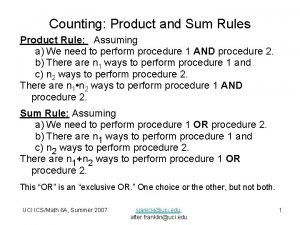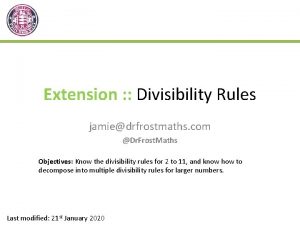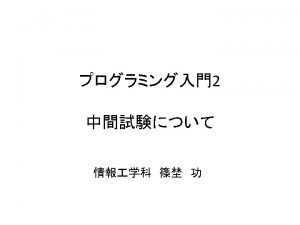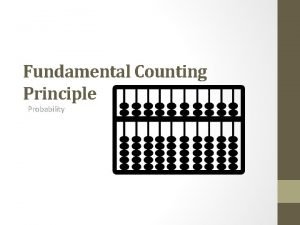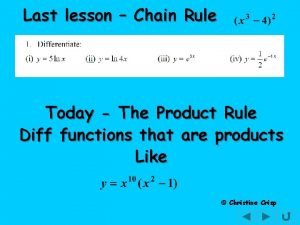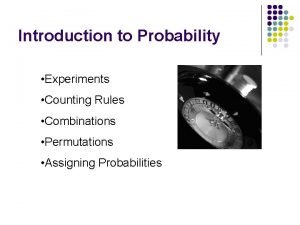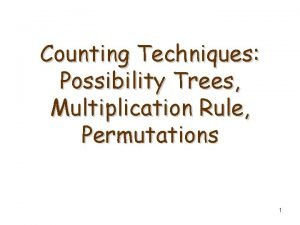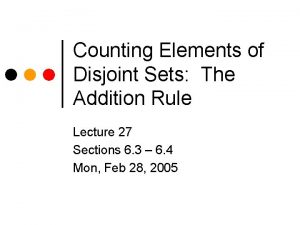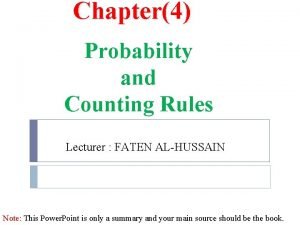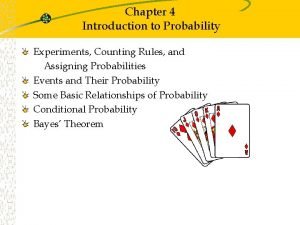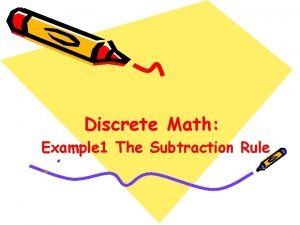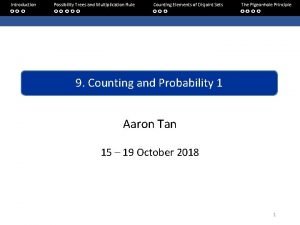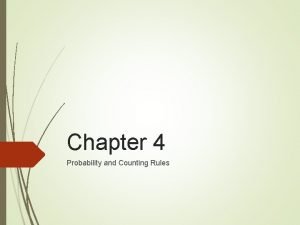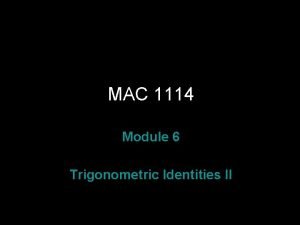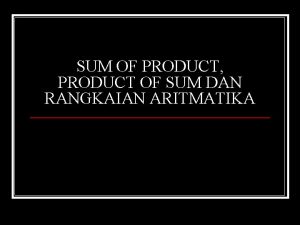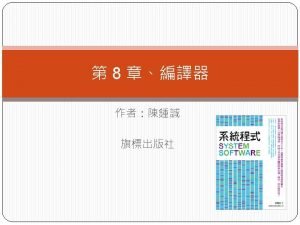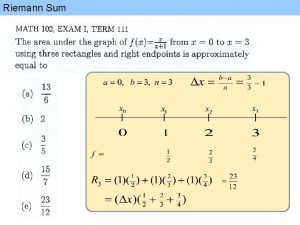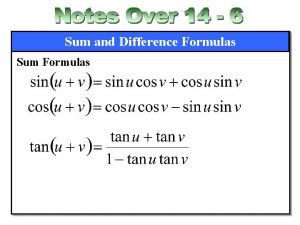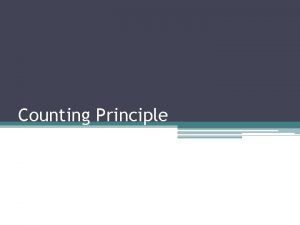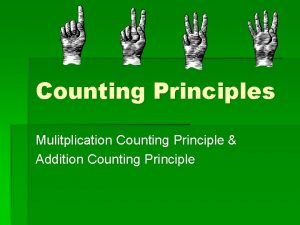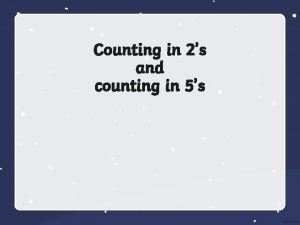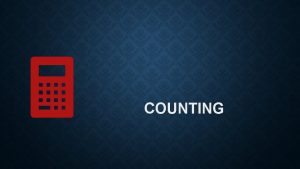Todays topics Counting Sum rule Product rule Tree















- Slides: 15

Today’s topics • Counting – – Sum rule Product rule Tree diagrams Inclusion/exclusion • Reading: Sections 4. 1 • Upcoming – Permutations & Combinations Comp. Sci 102 © Michael Frank 11. 1

Combinatorics • The study of the number of ways to put things together into various combinations. • E. g. In a contest entered by 100 people, – how many different top-10 outcomes could occur? • E. g. If a password is 6 -8 letters and/or digits, – how many passwords can there be? Comp. Sci 102 © Michael Frank 11. 2

Sum and Product Rules (§ 4. 1) • Let m be the number of ways to do task 1 and n the number of ways to do task 2, – with each number independent of how the other task is done, – and also assume that no way to do task 1 simultaneously also accomplishes task 2. • Then, we have the following rules: – The sum rule: The task “do either task 1 or task 2, but not both” can be done in m+n ways. – The product rule: The task “do both task 1 and task 2” can be done in mn ways. Comp. Sci 102 © Michael Frank 11. 3

Set Theoretic Version • If A is the set of ways to do task 1, and B the set of ways to do task 2, and if A and B are disjoint, then: – The ways to do either task 1 or 2 are A B, and |A B|=|A|+|B| – The ways to do both task 1 and 2 can be represented as A B, and |A B|=|A|·|B| Comp. Sci 102 © Michael Frank 11. 4

IP Address Example • Some facts about the Internet Protocol, version 4: – Valid computer addresses are in one of 3 types: • A class A IP address contains a 7 -bit “netid” ≠ 17, and a 24 -bit “hostid” • A class B address has a 14 -bit netid and a 16 -bit hostid. • A class C addr. Has 21 -bit netid an 8 -bit hostid. – The 3 classes have distinct headers (0, 110) – Hostids that are all 0 s or all 1 s are not allowed. • How many valid computer addresses are there? e. g. , duke. edu is 152. 3. 233. 10 Comp. Sci 102 © Michael Frank 11. 5

IP address solution • (# addrs) = (# class A) + (# class B) + (# class C) (by sum rule) • # class A = (# valid netids)·(# valid hostids) (by product rule) • • • (# valid class A netids) = 27 − 1 = 127. (# valid class A hostids) = 224 − 2 = 16, 777, 214. Continuing in this fashion we find the answer is: 3, 737, 091, 842 (3. 7 billion IP addresses) Comp. Sci 102 © Michael Frank 11. 6

Inclusion-Exclusion Principle (§§ 4. 1 & 6. 5) • Suppose that k m of the ways of doing task 1 also simultaneously accomplish task 2. – And thus are also ways of doing task 2. • Then, the number of ways to accomplish “Do either task 1 or task 2” is m n k. • Set theory: If A and B are not disjoint, then |A B|=|A| |B| |A B|. – If they are disjoint, this simplifies to |A|+|B|. Comp. Sci 102 © Michael Frank 11. 7

Inclusion/Exclusion Example • Some hypothetical rules for passwords: – Passwords must be 2 characters long. – Each character must be a letter a-z, a digit 0 -9, or one of the 10 punctuation characters !@#$%^&*(). – Each password must contain at least 1 digit or punctuation character. Comp. Sci 102 © Michael Frank 11. 8

Setup of Problem • A legal password has a digit or puctuation character in position 1 or position 2. – These cases overlap, so the principle applies. • (# of passwords w. OK symbol in position #1) = (10+10)·(10+10+26) • (# w. OK sym. in pos. #2): also 20· 46 • (# w. OK sym both places): 20· 20 • Answer: Comp. Sci 102 © Michael Frank 11. 9

Pigeonhole Principle (§ 4. 2) • A. k. a. the “Dirichlet drawer principle” • If ≥k+1 objects are assigned to k places, then at least 1 place must be assigned ≥ 2 objects. • In terms of the assignment function: – If f: A→B and |A|≥|B|+1, then some element of B has ≥ 2 preimages under f. • I. e. , f is not one-to-one. Comp. Sci 102 © Michael Frank 11. 10

Example of Pigeonhole Principle • There are 101 possible numeric grades (0%100%) rounded to the nearest integer. – Also, there are >101 students in this class. • Therefore, there must be at least one (rounded) grade that will be shared by at least 2 students at the end of the semester. – I. e. , the function from students to rounded grades is not a one-to-one function. Comp. Sci 102 © Michael Frank 11. 11

Fun Pigeonhole Proof (Ex. 4, p. 314) • Theorem: n N, a multiple m>0 of n m has only 0’s and 1’s in its decimal expansion! • Proof: Consider the n+1 decimal integers 1, 111, …, 1� 1. They have only n possible residues mod n. n+1 So, take the difference of two that have the same residue. The result is the answer! □ Comp. Sci 102 © Michael Frank 11. 12

A Specific Case • Let n=3. Consider 1, 111, 1111. – 1 mod 3 = 1 Note same residue. – 11 mod 3 = 2 – 111 mod 3 = 0 Lucky extra solution. – 1, 111 mod 3 = 1 • 1, 111 − 1 = 1, 110 = 3· 370. – It has only 0’s and 1’s in its expansion. – Its residue mod 3 = 0, so it’s a multiple of 3. Comp. Sci 102 © Michael Frank 11. 13

Another Fun Example • Suppose that next June, the Durham Bulls play at least 1 game a day, but ≤ 45 games total. Show there must be some sequence of consecutive days in June during which they play exactly 14 games. – Proof: Let aj be the number of games played on or before day j. Then, a 1, …, a 30 Z+ is a sequence of 30 distinct integers with 1 ≤ aj ≤ 45. Therefore a 1+14, …, a 30+14 is a sequence of 30 distinct integers with 15 ≤ aj+14 ≤ 59. Thus, (a 1, …, a 30, a 1+14, …, a 30+14) is a sequence of 60 integers from the set {1, . . , 59}. By the Pigeonhole Principle, two of them must be equal, but ai≠aj for i≠j. So, ij: ai = aj+14. Thus, 14 games were played on days aj+1, …, ai. Comp. Sci 102 © Michael Frank 11. 14

Baseball problem illustrated • Example of {ai}: Note all elements are distinct. – 1, 2, 4, 5, 7, 8, 10, 11, 13, 14, 16, 17, 19, 21, 22, 23, 25, 27, 29, 30, 31, 33, 34, 36, 37, 39, 40, 41, 43, 45 – Then {ai+14} is the following sequence: 15, 16, 18, 19, 21, 22, 24, 25, 27, 28, 30, 32, 33, 35, 36, 37, 39, 41, 43, 44, 45, 47, 48, 50, 51, 53, 54, 55, 57, 59 Thus, for example, exactly 14 games were played during days 3 to 11: 2+1+2+1+2 • In any 60 integers from 1 -59 there must be some duplicates, indeed we find the following ones: – 16, 19, 21, 22, 25, 27, 30, 33, 36, 37, 39, 41, 43, 45 Comp. Sci 102 © Michael Frank 11. 15
 Product sum rule
Product sum rule Dr frost
Dr frost Product and sum rule
Product and sum rule Int sum(int a int n) int sum=0 i
Int sum(int a int n) int sum=0 i How to draw a tree diagram for probability
How to draw a tree diagram for probability What is the cold chain rule
What is the cold chain rule Counting rules probability
Counting rules probability Multiplication rule for counting
Multiplication rule for counting Addition rule of counting
Addition rule of counting Simple event definition math
Simple event definition math Counting rule for multiple-step experiments
Counting rule for multiple-step experiments Subtraction rule example
Subtraction rule example Multiplication rule of counting
Multiplication rule of counting Chapter 4 probability and counting rules
Chapter 4 probability and counting rules Half angle formula examples
Half angle formula examples Sum and product softuni
Sum and product softuni
